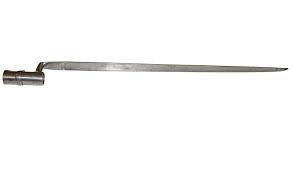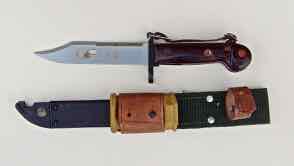| Author |
Message |
|
Michael Sandoval
|
 Posted: Tue 27 Aug, 2019 9:45 pm Post subject: Sword Bayonets - Use; Sharp Edge? Posted: Tue 27 Aug, 2019 9:45 pm Post subject: Sword Bayonets - Use; Sharp Edge? |
 |
|
For those interested in bayonets - here's a question that's been on my mind: Sword bayonets - were they expected to be sharpened by the soldier? Or did the higher-ups frown upon this? Did the philosophy of the use of a sword bayonet as both a slashing-thrusting weapon change as the 19th century went on? So that during the latter part of the 19th century, sword bayonets were really meant only for the thrust?
Clearly, the design of other bayonets indicate a specific set of rules for usage. A socket spiked bayonet from the Civl War transforms the rifle into a thrust-oriented spear. An AK-47 AKM Type 1 bayonet is a utilitarian knife that with a slot that in with the sheath, creates a wire cutter...
Some people seem to think that even sword bayonets, like the French Chassepot Yataghan, were never meant to be sharpened -- that the offset curved design was only meant to prevent the hand from being stuck during muzzle loading (which it does). The French Chassepot does come dull from the original manufacturer.
Yet the Chassepot and Enfield sword bayonet seem clearly inspired by the Turkish yataghan... Matt Easton talks about the design being meant by some early proponents for hand slashing.
Was this design truly meant to double as a back-up sword? As such, does the steel hold up to sharpening?
Would a quality sharpening of an antique yataghan blade decrease its value? Or would it matter, if indeed they were meant to be sharpened in the first place?
Thanks for your thoughts!
 Attachment: 1.76 KB Attachment: 1.76 KB

 Attachment: 6.77 KB Attachment: 6.77 KB

 Attachment: 6.39 KB Attachment: 6.39 KB

 Attachment: 7.18 KB Attachment: 7.18 KB

|
|
  |
 |
Glen A Cleeton

|
 Posted: Wed 28 Aug, 2019 4:56 am Post subject: Posted: Wed 28 Aug, 2019 4:56 am Post subject: |
 |
|
Sword and knife bayonets were designed to be sharpenable.
Cheers
GC
|
|
  |
 |
|
Michael Beeching
|
 Posted: Wed 28 Aug, 2019 10:12 am Post subject: Posted: Wed 28 Aug, 2019 10:12 am Post subject: |
 |
|
I believe Matt Easton has offered past commentary on the general matters of 19th century edged weapons on his YouTube channel. Those arms seemed not to have been issued with edges out of concerns for safety. Once those weapons would have been deployed to a combat area, however, they would have been "service sharpened."
It's possible that if you have a dull or unsharpened article, it was simply never put to use... which is probably a good thing! In fact, I have a 1937 Mauser 98 bayonet which I picked up from a gun show a few years back, and I do not believe it ever received a sharp edge. So there's that.
Concerning restoration - your mileage may vary. I do not like "junk" or things with patina for the sake of patina - that's just the point where someone stopped taking care of their weapon. If you do like worn out weapons as collectibles, I will assume sharpening will most definitely reduce their value. Or, it may be so old that changing it to suit your preferences may pose a legitimate threat to the historical value the item holds. With items in-between, like WWI and WWII weapons, you probably have a bit of leeway. They are diminishing in quantity, but they are not necessarily scarce, and they were often not of exceptional quality in the first place. So, for my Mauser bayonet, I think thoughts of restoring it are not out of place - in fact, I have seen people do beautiful restorations of even older Mauser bayonets than the one I have (the fact that it was re-stamped after the war doesn't help its collector's value). I see such restorations of in-between arms as a way of helping their conservation, so long as the restoration is done properly and respectfully, rather than as something which reduces value. Of course, there is a point where something can become so degraded that restoration is not possible, and any attempt really would just turn the artifact into garbage.
Concerning martial use of bayonets... that needs to be left to someone else. You see long bayonets with either long rifles (think spears) or for use as engineer's tools. A bayonet is also often a compromised knife design, though some are darn good (like the Mauser and the still-used M7). The more goofy stuff you try to make it do, the more it does each task with less effectiveness, durability, or comfort.
As a last quip, Chasspot bayonets have beautiful blades, but those hilts are so ugly. 
|
|
  |
 |
|
Graham Shearlaw
|
 Posted: Wed 28 Aug, 2019 12:11 pm Post subject: Posted: Wed 28 Aug, 2019 12:11 pm Post subject: |
 |
|
There's a method to the madness of sharpening a bayonet on one side only to avoid the blade getting stuck.
But that may just be an old soldiers tale like not oiling it or the saw backed butcher blades an triangle shaped ones unstitchable an being banned.
(Poison is banned as are shapes that add to the suffering.
Saw backs are for tree cutting and triangle shaped holes are stitchable)
There's still a clear logic to not sharpening it until you need to, it cuts down on the injury's in practice an that means that the store department/ factory don't have sharpen tens of thousands bayonet when the soldiers can do it.
|
|
  |
 |
|
Michael Beeching
|
 Posted: Wed 28 Aug, 2019 2:30 pm Post subject: Posted: Wed 28 Aug, 2019 2:30 pm Post subject: |
 |
|
Never heard about the first part of your comment... and I'm not sure exactly what you mean, either! Is this in relation to double-edged bayonets or blades with either only single edges or partial edges (literal short edges)? Partial-edged bayonets, like those derived from the M3 trench knife, are made the way they are to improve their strength. Otherwise, why not have a full length double-edged weapon?
Heh... not oiling the blade sounds like a good excuse for not maintaining your weapons. On another note, the idea might have been that an unsanitary weapon, upon penetrating its target, would cause an infection even if the victim survived the confrontation.
Next, odd-shaped blades can certainly cause grievous wounds... Supposedly T-cross-sectioned blades were particularly nasty. A hollow-ground triangle blade would be nothing to besmirch. The saw-blade thing was definitely a propaganda thing, though. But it seems the Germans believed it and removed a lot of the saw teeth on the K98 bayonets. I'm sure a lot of the Allies believed the propaganda as well, unfortunately, and really might have executed soldiers found with those knives.
Last, your last point is right there. However, I'm not sure soldiers in the 1800s would be expected to sharpen their own bayonets from that state. It's not that its an overly hard task (I'm sure a lot of us here have bought Windlass-brand knives and swords and did not bother to pay for someone else to do the sharpening), but working your way through a "virgin" edge can be a lot of work for someone who may not have a good understanding of how to do that job or may not have good tools for quickly and easily doing it. Therefore, I think there's a good chance that issued weapons like bayonets would be sharpened by the unit's armorers. Today I think most all knives are personal weapons, but I'm sure it often wasn't like that "back in the day."
|
|
  |
 |
|
Graham Shearlaw
|
 Posted: Thu 29 Aug, 2019 4:20 pm Post subject: Posted: Thu 29 Aug, 2019 4:20 pm Post subject: |
 |
|
The idea of only shapring one side was so that you only cut one rib and lessen the chance of it getting stuck.
No i'm not sure that's really why there's often an unsharpened edge, durability and better utility sound like better answers to me.
Today I think most all knives are personal weapons, but I'm sure it often wasn't like that "back in the day."
Guns and bayonets where certainly a personal weapon in that you have to maintain it and keep it up to stranded .
|
|
  |
 |
|
Michael Sandoval
|
 Posted: Fri 30 Aug, 2019 12:31 am Post subject: Posted: Fri 30 Aug, 2019 12:31 am Post subject: |
 |
|
Excellent comments, here.
Michael, I like your reminder that units would have an armorer who could sharpen these en masse. Makes sense. I also have an old Mauser bayonet that I picked up for next to nothing at a gun show. Sharpening/re-profiling was not easy — ended up taking it to a professional. I can’t imagine individual soldiers with no grinder at hand expected to do this well; at least not for a 22” long Sword bayonet blade!
Yes, these were meant for more than poking. The comment section in one of Matt Easton’s videos describes first-hand sources where individual soldiers fought or killed the enemy with the sword bayonet in hand.
|
|
  |
 |
|
|
You cannot post new topics in this forum
You cannot reply to topics in this forum
You cannot edit your posts in this forum
You cannot delete your posts in this forum
You cannot vote in polls in this forum
You cannot attach files in this forum
You can download files in this forum
|
All contents © Copyright 2003-2025 myArmoury.com — All rights reserved
Discussion forums powered by phpBB © The phpBB Group
Switch to the Basic Low-bandwidth Version of the forum
|

